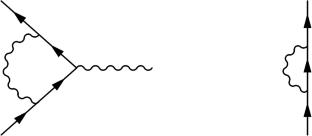How Anomalous is the Electron’s Magnetic Moment?
Abstract
The electron’s spin magnetic moment is ordinarily described as anomalous in comparison to what one would expect from the Dirac equation. But, what exactly should one expect from the Dirac equation? The standard answer would be the Bohr magneton, which is a simple estimate of the electron’s spin magnetic moment that can be derived from the Dirac equation either by taking the non-relativistic limit to arrive at the Pauli equation or by examining the Gordon decomposition of the electron’s current density. However, these derivations ignore two effects that are central to quantum field theoretic calculations of the electron’s magnetic moment: self-interaction and mass renormalization. Those two effects can and should be incorporated when analyzing the Dirac equation, to better isolate the distinctive improvements of quantum field theory. Either of the two aforementioned derivations can be modified accordingly. Doing so yields a magnetic moment that depends on the electron’s state (even among z-spin up states). This poses a puzzle for future research: How does the move to quantum field theory take you from a state-dependent magnetic moment to a fixed magnetic moment?


 求助内容:
求助内容: 应助结果提醒方式:
应助结果提醒方式:


